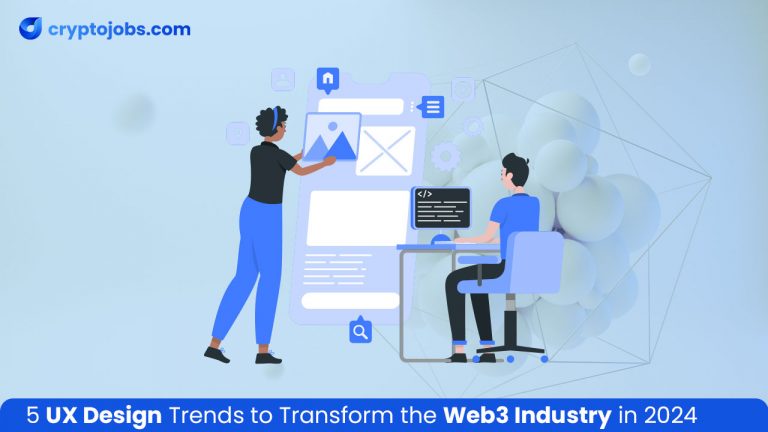
5 UX Design Trends to Transform the Web3 Industry in 2024
- cryptojobs.com
- February 15, 2024
- All Posts, Web3
- 0 Comments
They often say, “Don’t judge a book by its cover,” yet when it comes to user interfaces, the cover plays a pivotal role, profoundly influencing user comfort and engagement. In a world where screen time is skyrocketing, daily activities from entertainment to financial transactions have migrated online. Users now crave seamless and visually captivating experiences.
To remain relevant and fulfill user demands, contemporary Web3 UI/UX designs must transcend mere artistic principles like composition, perspective, and color theory. They must also consider factors such as color psychology, symbolism, and accessibility fundamentals. By integrating these elements, a Web3 UX designer can craft more impactful and user-centric experiences that resonate with a broader audience.
This article delves into the prevailing UI/UX design trends of 2024 that have the potential to transform the Web3 industry.
Immersive Design
The ascent of immersive technologies such as virtual reality (VR) and augmented reality (AR) has reshaped the landscape of user interactions. AR’s omnipresence in Web3 UX design is no longer a forecast; it is the present reality. Extending far beyond its roots in gaming, AR now infiltrates sectors ranging from eCommerce to education and healthcare, presenting designers with a wealth of opportunities to innovate.
Immersive experiences redefine the user journey, beckoning users not merely to observe but to actively engage with their digital surroundings. AR enables individuals to step into meticulously crafted realities, empowering them to manipulate and interact with digital elements in ways previously unimaginable.
You may like to read our Career Guide for Becoming a UI/UX Designer
Yet, amidst the excitement surrounding AR’s potential lies a pressing need for safety and ethical considerations. As AR blurs the lines between digital and physical realities, Web3 UX designers must prioritize user safety and adhere to ethical design principles to mitigate potential risks. The fusion of technology and design holds the key to unlocking new dimensions of engagement and interaction in the Web3 era.
Decentralized Design Principles
Decentralized design principles are rapidly changing the very foundation of the user experience (UX) in the Web3 sector. At the heart of this paradigm shift lies the concept of decentralization, which fundamentally alters traditional notions of authority, ownership, and trust. Decentralized design transcends conventional paradigms by prioritizing principles of transparency, autonomy, and security.
Decentralized technologies, such as blockchain and distributed ledger technology (DLT), empower users with greater autonomy and control over their digital interactions. Through peer-to-peer networks and consensus mechanisms, a Web3 UX designer prioritizes privacy, security, and user sovereignty, paving the way for a more inclusive and equitable online experience. By decentralizing data storage, transaction validation, and governance mechanisms, these technologies eliminate single points of failure and foster a more resilient and transparent digital environment.
NFT-driven Experiences
With blockchain integration, non-fungible tokens (NFTs) have emerged as a driving force behind groundbreaking user experiences. These unique digital assets have revolutionized ownership in the digital space, offering unprecedented opportunities for creators and users alike.
NFT-driven experiences represent a paradigm shift in the way we interact with digital content. From virtual art galleries to immersive gaming experiences, NFTs are reshaping the landscape of digital entertainment and commerce. By tokenizing digital assets and leveraging decentralized platforms, creators can monetize their work directly, bypassing traditional intermediaries and unlocking new revenue streams.
In the world of UI/UX design, NFT-driven experiences present exciting possibilities for innovation and creativity. UX designers are integrating NFTs into user interfaces to offer users unique and personalized interactions with digital content. Whether it’s collecting rare digital assets, participating in decentralized marketplaces, or engaging in interactive storytelling experiences, NFT-driven interfaces open up a world of possibilities for user engagement and immersion.
AI Integration
The integration of artificial intelligence (AI) has become increasingly prevalent in web design. AI algorithms are revolutionizing the way designers approach user interfaces, offering insights and recommendations based on vast amounts of data. Incorporating AI into the design process enables a Web3 UX designer to streamline tasks, enhance efficiency, and deliver more personalized experiences to users. From predictive analytics to automated design generation, AI-driven tools empower designers to make data-informed decisions and iterate rapidly.
One prominent example of AI integration in design is the use of machine learning algorithms to analyze user behavior and preferences. By gathering data on how users interact with interfaces, AI can identify patterns and trends, enabling designers to optimize layouts, features, and content to better meet user needs. AI-powered design tools can automate repetitive tasks, such as layout adjustments, freeing up designers to focus on more creative and strategic aspects of the design process. This not only accelerates the design workflow but also ensures consistency and quality across projects.
By leveraging data on user interactions, AI can dynamically adjust content, recommendations, and interactions to create more engaging and relevant experiences for each user. With it, designers can unlock new possibilities and push the boundaries of creativity in Web3 UI/UX design.
Scrollytelling
Embarking on a digital journey often involves scrolling through vast amounts of content. Enter scrollytelling. Scrollytelling is a term coined from the fusion of “scrolling” and “Storytelling.” It encapsulates the immersive narrative experiences created through interactive scrolling interfaces. Whether it’s a captivating timeline, a dynamic data visualization, or a compelling narrative unfolding as users scroll, scrollytelling engages users in a fluid and intuitive manner, enhancing their journey through digital content.
You may like to know about Challenges and Opportunities for UX Designers in 2024
In the world of Web3 UX design, scrollytelling emerges as a powerful tool for captivating user attention and immersing them in a compelling narrative experience. By seamlessly blending text, imagery, and interactive elements along the scroll path, designers craft immersive storytelling experiences that unfold as users navigate through the content. This approach not only enhances user engagement but also offers a more intuitive and interactive way to convey complex information and evoke emotional responses.
Conclusion
To summarize, the UX design trends shaping the Web3 industry in 2024 reflect a union of innovation, technology, and user-centricity. As designers and businesses navigate this dynamic landscape, it’s crucial to embrace innovation and adapt to the evolving needs and expectations of users. By staying abreast of emerging trends and leveraging cutting-edge technologies, UX designers can create impactful and engaging experiences that resonate with users in the Web3 era.
Finding a Web3 job in the competitive web3 space can be stress-free with cryptojobs.com, as the platform is trusted by top Web3 and crypto companies for hiring the best talent. Start your job search today and find a position that matches your skillset.




